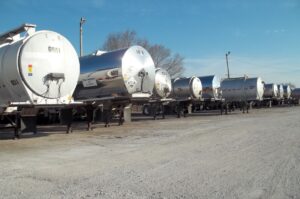A cargo tank is a type of packaging that when combined with a motor vehicle for highway transportation becomes a cargo tank motor vehicle (commonly referred to as a tanker truck). While its operation on a public roadway is the responsibility of the motor carrier, the responsibility to ensure attendance during loading or unloading of the cargo tank may be the responsibility of the motor carrier, the shipper of the HazMat, i.e., the person who offers it for transportation, a person operating the facility where transportation begins or ends, a contractor working for any one of the previous, or a third party.
The Hazardous Materials Regulations (HMR) of the Pipeline and Hazardous Materials Safety Administration within the U.S. Department of Transportation (USDOT/PHMSA) regulate the loading and unloading of a cargo tank when it is performed incidental to transportation. It is the HMR that indicates who is responsible to ensure attendance by a qualified person at all times during loading and unloading of HazMat from a cargo tank.
The purpose of this article is to identify and explain the attendance requirements of USDOT/PHMSA at 49 CFR 177.834(i) of the HMR for the loading and unloading of hazardous materials from a cargo tank.
Scope and Applicability:
This article will solely address the responsibilities of the carrier during the loading and unloading of hazardous materials from a cargo tank. However, subject to §173.30, if a shipper conducts or participates in the loading or unloading of a cargo tank they must comply, as well as the carrier, with the regulations of §177.834(i). (LOI 98-0260)

The regulations of §177.834(i) – in truth, the entire HMR – do not apply to loading or unloading of a cargo tank that takes place before transportation has begun or after it is ended.
Shipper personnel filling a cargo tank prior to the onset of transportation in commerce (i.e., the arrival of the carrier and the attachment of motive power) need not comply with the attendance requirements in § 177.834(i). Similarly, the attendance requirements in §177.834(i) do not apply to unloading operations conducted by consignee personnel after the carrier delivers the cargo tank, disconnects the motive power, and leaves the unloading site. (LOI-05-0300)
Daniels Training Services, Inc. 815.821.1550 |
This article will not address the following:
- The pre-transportation functions of §173.33 specific to the use of cargo tanks as a type of HazMat packaging. These are the responsibility of the shipper. Note: if a person other than the shipper (e.g., the motor carrier) performs or is responsible for performing one of the pre-transportation functions of §173.33, they will be subject to compliance as the shipper.
- The loading and unloading requirements for specific to the following HazMat:
- §177.835 – Class 1 Explosives
- §177.837 – Class 3 Flammable and Combustible Liquids
- §177.838 – Division 4.1 Flammable Solids, Division 5.1 Oxidizers, and Division 4.2 (self-heating and pyrophoric liquids)
- §177.839 – Class 8 Corrosive Substances
- §177.840 – Class 2 Compressed gases
- §177.841 – Division 6.1 Poisonous Materials and Division 2.3 Poisonous Gas
- §177.842 – Class 7 Radioactive Material
The General Requirements of §177.834(c,d,e):
Though not found in §177.834(i), these general requirements apply to all loading and unloading of HazMat into or from a motor vehicle (including non-bulk packages from a cargo trailer) and should be complied with when loading or unloading a cargo tank.:
- No smoking (this does not include e-cigarettes per LOI 13-0079) on or about any motor vehicle and use extreme care to keep fire away and prevent persons in the vicinity from smoking, lighting matches, or carrying any flame or lighted cigar, pipe, or cigarette while loading or unloading any of the following:
- Class 1 Explosives
- Class 3 Flammable Liquids
- Division 4.1 Flammable Solids
- Division 5.1 Oxidizer
- Division 2.1 Flammable Gas
- Handbrake must be securely set and all other reasonable precautions taken to prevent motion of the vehicle during loading or unloading.
Attendance Requirements During the Loading and Unloading of a Cargo Tank (§177.834(i)):
The attendance requirements are divided between loading and unloading operations; these will be explained separately. Key terms include “attendance” and “qualified person”; each of which will be described in-depth.
Contact me with any questions you may have about the transportation of hazardous materials by air, highway, vessel, or rail International and Domestic Daniels Training Services, Inc. 815.821.1550 |
Loading a Cargo Tank (§177.834(i)(1)):
The cargo tank must be attended by a qualified person at all times during its loading. The statement is clear but some of the words used require further explanation (“attended”? “qualified”?) and will get it later in this article.
One thing clear in this regulation is the requirement a qualified person be in attendance, “…at all times when it (the cargo tank) is being loaded.”
Deliberately vague is the requirement that the person responsible for loading the cargo tank is also responsible for ensuring it is so attended. This is an instance where the regulation’s applicability depends upon who assumes – or is required to assume – the responsibility for the regulated activity. The responsibility to ensure attendance by a qualified person during loading of a cargo tank may be that of the shipper, the carrier, or a third party (perhaps the owner or operator of the site where the loading takes place). Given the possibility of confusion with the applicability of this regulation, I strongly advise all parties to determine who will be responsible for loading of the cargo tank and ensure they are familiar with their responsibilities and can perform them.
And notice, the regulation does not require the person responsible for loading the cargo tank to attend its loading or to direct one of their employees to attend. Rather, they must ensure the loading is attended by a qualified person at all times. This means that any qualified person could be in attendance during the loading of the cargo tank (e.g., a contractor unrelated to transportation), but the responsibility to ensure their attendance belongs to the person responsible for loading the cargo tank.
Unloading a Cargo Tank (§177.834(i)(2)):
The cargo tank must be attended by a qualified person at all times during its unloading. Once again, the words “attended” and “qualified” require – and will receive – clarification later in this article.
Similar to the loading operation, the regulation clearly states a qualified person must be in attendance, “…at all times during unloading (of a cargo tank).”
The regulations for attendance during unloading of a cargo tank differ from those for loading in the clear assignment of who is responsible to ensure attendance by a qualified person: “A motor carrier who transports hazardous materials by a cargo tank must ensure that the cargo tank is attended by a qualified person at all times during unloading.” So, it’s all on the motor carrier.
However, the motor carrier’s obligation to ensure attendance during unloading does not apply when all of the following has taken place:
- The carrier’s obligation for transporting the HazMat is fulfilled.
- The cargo tank has been placed on the property of the destination (aka: consignee).
- The motive power has been separated from the cargo tank and removed from the property.
Again, the regulation does not require a representative of the carrier to attend the unloading of the cargo tank. Rather, the motor carrier must ensure the unloading is attended by a qualified person at all times.
Interested in a Webinar that covers this topic, and more! |
What is “attends”? (§177.834(i)(3))
There are three options for how a qualified person may be in attendance throughout the process of loading or unloading a cargo tank. These three options are:
- In person, unobstructed view.
- Remote location.
- Transfer hoses with quick shut-off.
1. In person, unobstructed view:
- Qualified person is within 7.62 m (25 feet) of the cargo tank. This means a straight line distance; an actual walking distance and not a field of view (LOI 12-0132).
- Qualified person is alert. “The term “alert” is typically defined as ‘quick to notice any unusual and potentially dangerous or difficult circumstances.’ In the event of an emergency, a person that is ‘alert’ will be able to rapidly halt the process and take immediate action.” (LOI 13-0050)
- Qualified person has an unobstructed view of the cargo tank and delivery hose to the maximum extent practicable during loading and unloading.
The following unloading operations are not subject to the above and instead must comply with “in person” requirements specific to them:
- The unloading of a Class 3 Combustible Liquid from a cargo tank subject to §177.837(d).
- Unloading procedures for liquefied petroleum gas and anhydrous ammonia in metered delivery service subject to §177.840(p).
- Unloading procedures for liquefied petroleum gas and anhydrous ammonia in other than metered delivery service subject to §177.840(q).
Like this article? Subscribe to my Monthly Newsletter No marketing emails! |
2. Remote location:
A qualified person (this person does not need to meet all of the requirements for “qualified” described below) may observe all loading or unloading operations from a remote control station by either of the following:
- Video cameras and monitors.
- Instrumentation and signaling systems. To include:
- Sensors
- Alarms
- Electronic surveillance equipment.
The loading or unloading system must be equipped as follows:
- For a video monitoring system, the camera must be mounted to provide an unobstructed view of all equipment involved in the loading or unloading. This includes all of the following:
- Valves
- Hoses
- Domes
- Pressure relief devices
- For an instrumentation and signaling system, it must provide a surveillance capability at least equal to that of a human observer.
- Upon loss of either video monitoring capability or instrumentation and signaling systems, loading or unloading operation must be immediately terminated.
- Shut-off valves operable from the remote control station must be provided.
- In the event of a remote system failure, a qualified person must immediately resume attending the loading or unloading of the cargo tank “In person, unobstructed view” as described above (§177.834(i)(3)(i)).
- A containment area must be provided capable of holding the contents of as many cargo tanks as might be loaded at any single time.
- A qualified person must personally conduct a visual inspection of each cargo tank motor vehicle after it is loaded, prior to departure, for any damage that may have occurred during loading. Note: this requirement applies to the loading of a cargo tank but not to its unloading.
3. Transfer hose with quick shut-off:
Hoses used during loading or unloading operations must be able to stop the flow of HazMat from both the source and the receiving tank within one second without human intervention in the event of a hose rupture, disconnection, or separation. Hoses must be equipped with one of the following at each end of the hose:
- Cable-connected wedges
- Plungers
- Flapper valves
Also…
- The hose must be inspected prior to each use to ensure it is of sound quality and without defects visible through visual observation. Note: this inspection must be completed by a qualified person but that person is not subject to all of the regulations in order to be “qualified” (more on this in the next section).
- The loading or unloading operation must be physically inspected by a qualified person at least once every sixty 60 minutes.
Q: Do the attendance requirements of §177.834(i)(3) apply if an outside contractor unloads a cargo tank?
A: Yes. Any outside contractor used to fulfill the loading or unloading attendance requirements must be in compliance with §177.834(i). (LOI 13-0050)
Daniels Training Services, Inc. 815.821.1550 |
How is a person “qualified”? (§177.834(i)(4))
A person is “qualified” to attend the loading or unloading of a cargo tank if he/she…
- Has been made aware of the nature of the hazardous material to be loaded or unloaded.
- Has been instructed on the procedures to follow in an emergency.
- Is authorized to move the cargo tank.
And…
- Has the means to move the cargo tank.
The requirement for the qualified person to be authorized to move the cargo tank and have the means to do so does not apply to the following persons:
- A person observing loading or unloading operations by means of video cameras and monitors or instrumentation and signaling systems from a remote location.
- A person inspecting hoses prior to each use to ensure it is able to stop the flow of HazMat if rupture, disconnection or separation.
In addition to the above, the “qualified” person must receive HazMat Employee training pursuant to 172, subpart H and must include: General Awareness, Function-Specific, Safety, and Security awareness. In-Depth Security and Driver Training are also required if applicable (LOI 10-0225).
Q: Is a terminal operator considered to be “qualified” (i.e., is authorized to move the cargo tank and has the means to do so) when in radio contact with a driver who can respond within 2-3 minutes to an emergency situation.
A: No. In the above scenario neither the terminal operator nor the driver is qualified (LOI 00-0259)
Contact me the next time your USDOT, IATA (air), or IMO (vessel) training is due to expire. |
Conclusion:
The loading and unloading of a cargo tank is a time when a spill or release of a hazardous material could result in harm to a person and/or significant damage to the environment. Make sure any loading or unloading operations for which you are responsible are performed safely under the watchful attendance of a qualified person. And, make certain that all personnel with a direct effect on the safe transportation of hazardous materials receive initial (within 90 days) and recurrent (within three years) USDOT HazMat Employee Training.
